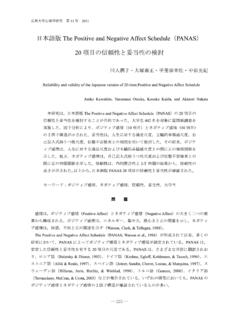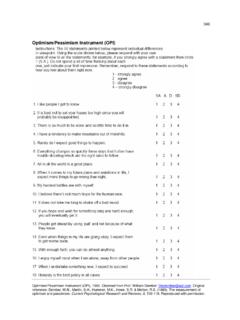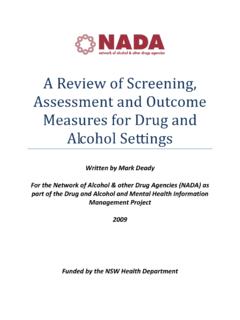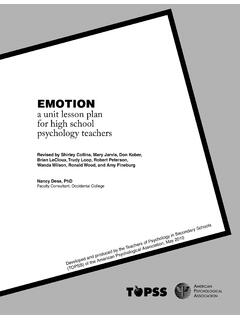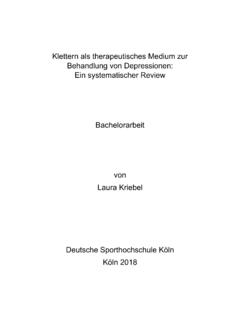Transcription of Development and Validation of Brief Measures of Positive ...
1 Journal of Personality and Social Psychology Copyright 1988 by the American Psychological Association, Inc. 1988. Vol. 54. No. 6, 1063-1070 G022-35l4/88/$ Development and Validation of Brief Measures of Positive and negative affect : The PANAS Scales David Watson and Lee Anna Clark Southern Methodist University Auke Tellegen University of Minnesota This article is intended solely for the personal use of the individual user and is not to be disseminated broadly. In recent studies of the structure of affect , Positive and negative affect have consistently emerged as This document is copyrighted by the American Psychological Association or one of its allied publishers. two dominant and relatively independent dimensions.
2 A number of mood scales have been created to measure these factors; however, many existing Measures are inadequate, showing low reliability or poor convergent or discriminant validity. To fill the need for reliable and valid Positive affect and negative affect scales that are also Brief and easy to administer, we developed two 10-item mood scales that comprise the Positive and negative affect schedule (PANAS). The scales are shown to be highly internally consistent, largely uncorrelated, and stable at appropriate levels over a 2-month time period. Normative data and factorial and external evidence of convergent and discriminant validity for the scales are also presented. Two dominant dimensions consistently emerge in studies of ness and serenity.
3 These two factors represent affective state di- affective structure, both in the United States and in a number mensions, but Tellegen (1985; see also Watson & Clark, 1984). of other cultures. They appear as the first two factors in factor has demonstrated that they are related to corresponding affec- analyses of self-rated mood and as the first two dimensions in tive trait dimensions of Positive and negative emotionality (indi- multidimensional scalings of facial expressions or mood terms vidual differences in Positive and negative emotional reactivity). (Diener, Larsen, Levine, & Emmons, 1985; Russell, 1980, Trait PA and NA roughly correspond to the dominant personal- 1983; Stone, 1981; Watson, Clark, & Tellegen, 1984; Zevon & ity factors of extraversion and anxiety/neuroticism, respectively Tellegen, 1982).
4 (Tellegen, 1985; Watson & Clark, 1984). Drawing on these and Watson and Tellegen (1985) have summarized the relevant other findings, Tellegen has linked trait NA and PA, respectively, evidence and presented a basic, consensual two-factor model. to psychobiological and psychodynamic constructs of sensitiv- Whereas some investigators work with the unrotated dimen- ity to signals of reward and punishment. He has also suggested sions (typically labeled pleasantness-unpleasantness and that low PA and high NA (both state and trait) are major distin- arousal), the varimax-rotated factors usually called Positive guishing features of depression and anxiety, respectively (Tel- affect and negative affect have been used more extensively in legen, 1985; see also Hall, 1977).
5 The self-report mood literature; they are the focus of this article. Numerous PA and NA scales have been developed and stud- Although the terms Positive affect and negative affect might ied in a variety of research areas. Generally speaking, the find- suggest that these two mood factors are opposites (that is, ings from these studies indicate that the two mood factors relate strongly negatively correlated), they have in fact emerged as to different classes of variables. NA but not PA is related to highly distinctive dimensions that can be meaningfully repre- self-reported stress and (poor) coping (Clark & Watson, 1986;. sented as orthogonal dimensions in factor analytic studies of Kanner, Coyne, Schaefer, & Lazarus, 1981; Wills, 1986), health affect .
6 Complaints (Beiser, 1974;Bradburn, 1969; Tessler & Mechanic, Briefly, Positive affect (PA) reflects the extent to which a per- 1978; Watson & Pennebaker, in press), and frequency of un- son feels enthusiastic, active, and alert. High PA is a state of pleasant events (Stone, 1981; Warr, Barter, & Brownbridge, high energy, full concentration, and pleasurable engagement, 1983). In contrast, PA but not NA is related to social activ- whereas low PA is characterized by sadness and lethargy. In con- ity and satisfaction and to the frequency of pleasant events trast, negative affect (NA) is a general dimension of subjective (Beiser, 1974; Bradburn, 1969; Clark & Watson, 1986, 1988;. distress and unpleasurable engagement that subsumes a variety Watson, 1988).
7 Of aversive mood states, including anger, contempt, disgust, Anomalous and inconsistent findings have also been re- guilt, fear, and nervousness, with low NA being a state of calm- ported, however. For example, whereas most studies have found these NA and PA scales to have low or nonsignificant corre- lations with one another ( , Clark & Watson, 1986, 1988;. Harding, 1982; Moriwaki, 1974; Warr, 1978; Wills, 1986), oth- We wish to thank Lisa Binz, Sondra Brumbelow, Richard Cole, Mary ers have found them to be substantially related (Brenner, 1975;. Dieffenwierth, Robert Folger, Jay Leeka, Curt Mclntyre, James Pen- nebaker, and Karen Schneider for their help in collecting the data re- Diener & Emmons, 1984; Kammann, Christie, Irwin, &.)
8 Ported in this article. Dixon, 1979). There are many possible explanations for such Correspondence should be addressed to David Watson, Department inconsistencies ( , see Diener & Emmons, 1984), but one that of Psychology, Southern Methodist University, Dallas, Texas, 75275. must be considered concerns the various scales themselves. It 1063. 1064 D. WATSON, L. CLARK, AND A. TELLEOEN. may be, for example, that some scales are simply better, purer R- and P-analyses reported in Zevon & Tellegen (1982). Twenty Measures of the underlying factors than are others. Watson (in PA markers and 30 NA markers met this initial criterion. How- press) reported evidence supporting this idea. He found that ever, as noted previously, we were also concerned that the terms some scale pairs (such as those used by Diener and his associates not have strong secondary loadings on the other factor.
9 We in a number of studies; , Diener & Emmons, 1984; Diener & therefore specified that a term could not have a secondary load- Iran-Nejad, 1986; Diener et al., 1985) yield consistently higher ing of |.25| or greater in either analysis. This reduced the pool NA-PA correlations than do others (such as our own scales, to of candidate descriptors to 12 for PA and 25 for NA. be described shortly). Preliminary reliability analyses convinced us that 10 terms More generally, one must question the reliability and validity were sufficient for the PANAS PA scale; we therefore dropped 2. of many of these Measures . Some mood scales have been devel- terms (delightedand healthy) that had relatively high secondary oped through factor analysis ( , Stone, 1981), but others have loadings on NA.
10 This yielded the final list of 10 descriptors for been constructed on a purely ad hoc basis with no supporting the PA scale: attentive, interested, alert, excited, enthusiastic, reliability or validity data ( , McAdams & Constantian, inspired, proud, determined, strong and active. This article is intended solely for the personal use of the individual user and is not to be disseminated broadly. This document is copyrighted by the American Psychological Association or one of its allied publishers. 1983). Watson (in press) analyzed the psychometric properties The 25 NA candidate terms included all 3 terms from seven of several popular Measures and found many of them to be of the content categories (distressed, angry, contempt, revul- wanting, at least for use in student populations.)
